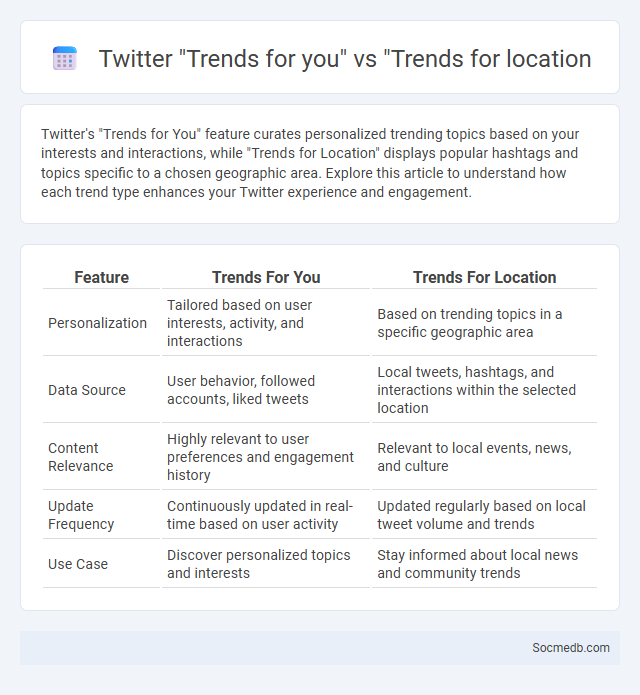
Photo illustration: Twitter trends for you vs trends for location
Twitter's "Trends for You" feature curates personalized trending topics based on your interests and interactions, while "Trends for Location" displays popular hashtags and topics specific to a chosen geographic area. Explore this article to understand how each trend type enhances your Twitter experience and engagement.
Table of Comparison
| Feature | Trends For You | Trends For Location |
|---|---|---|
| Personalization | Tailored based on user interests, activity, and interactions | Based on trending topics in a specific geographic area |
| Data Source | User behavior, followed accounts, liked tweets | Local tweets, hashtags, and interactions within the selected location |
| Content Relevance | Highly relevant to user preferences and engagement history | Relevant to local events, news, and culture |
| Update Frequency | Continuously updated in real-time based on user activity | Updated regularly based on local tweet volume and trends |
| Use Case | Discover personalized topics and interests | Stay informed about local news and community trends |
Understanding Twitter Trends: An Overview
Twitter trends reflect the most popular and widely discussed topics in real-time, driven by hashtags, keywords, and user engagement. Your ability to analyze these trends helps you stay informed about current events, public opinions, and emerging social movements globally. Utilizing tools like Twitter Analytics and third-party trend trackers enhances your understanding of the context and reach of trending topics.
What Are "Trends For You" on Twitter?
"Trends For You" on Twitter are personalized topic suggestions generated by an algorithm analyzing your location, interests, and accounts you follow. These trends highlight popular hashtags, news, and discussions tailored specifically to your activity and preferences. Monitoring your "Trends For You" helps you stay updated with relevant conversations and engage effectively within your Twitter community.
How Twitter's Trending Algorithm Works
Twitter's trending algorithm identifies popular hashtags, keywords, and topics by analyzing real-time data, including tweet volume, user engagement, and geographical trends. It filters out spam and repetitive content to ensure relevant and diverse trends surface on your feed. Understanding this process helps you tailor your content to gain visibility in trending conversations.
Comparing "Trends For You" vs. "Trends For Location
Trends For You" curates social media trends based on individual user behavior, preferences, and interactions, delivering personalized and relevant content. In contrast, "Trends For Location" aggregates popular topics and hashtags specific to a geographic area, reflecting regional interests and events. Understanding this distinction helps marketers and users target either personalized or local trend engagement effectively.
Factors Influencing Personalized Twitter Trends
Twitter trends are influenced by various factors including user location, trending hashtags, and follower interactions that tailor content to individual preferences. The Twitter algorithm analyzes user behavior such as retweets, likes, and engagement patterns to generate personalized trends. Demographics and real-time events also play crucial roles in shaping the trending topics visible to each user.
The Role of Location in Twitter Trending Topics
Location plays a crucial role in shaping Twitter trending topics by reflecting regional interests, events, and breaking news unique to specific areas. Trending hashtags and discussions often vary between cities and countries, offering your audience localized content that resonates with their immediate environment. Leveraging location-based trends can enhance engagement by aligning your social media strategy with the cultural and social dynamics of your target market.
User Engagement and Its Impact on Trending Lists
User engagement on social media platforms significantly influences trending lists by driving content visibility through likes, shares, comments, and watch time metrics. High engagement levels signal relevance and popularity to platform algorithms, which prioritize such content for wider distribution and trending status. Consequently, brands and content creators aim to maximize engagement to enhance exposure, increase follower growth, and boost organic reach within competitive social media ecosystems.
How to Customize Your Twitter Trending Experience
To customize your Twitter trending experience, start by accessing the trends settings on the platform and selecting your preferred location or opting for tailored trends based on your interests. Use the "See less often" option on unwanted trends to train Twitter's algorithm to display content more aligned with your preferences. Engaging regularly with topics and accounts relevant to your interests further refines the trending feed, providing a more personalized Twitter experience.
Common Misconceptions About Twitter Trends
Twitter trends often mislead users by implying widespread consensus or popularity when they may reflect localized or niche interests. The trending algorithm emphasizes engagement velocity rather than absolute tweet volume, resulting in temporary spikes dominated by a specific group or event. Misinterpretation of trends can cause skewed perceptions of public opinion and obscure deeper, ongoing conversations on the platform.
The Future of Trend Algorithms on Twitter
The future of trend algorithms on Twitter will likely leverage advanced machine learning models to enhance real-time data analysis and personalized content delivery. Integration of natural language processing and sentiment analysis could improve trend accuracy by filtering noise and identifying authentic user engagement. These developments aim to create more dynamic and relevant trending topics, increasing user interaction and platform value.
 socmedb.com
socmedb.com